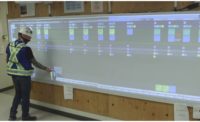Construction managment software firm Procore Inc. sold 9.47 million shares for $67 each in a May 20 initial public offering on the New York Stock Exchange. The technology startup and its bankers had marketed shares for $60 to $65 before its IPO, an exchange filing showed.
Listed under the ticker symbol PCOR, the stock outperformed its target and ended the trading day at $88 per share, giving the company a market value of more than $8.5 billion based on outstanding shares listed in its filings with the U.S. Securities and Exchange Commission.
"Procore’s IPO is a significant moment in our journey," CEO and founder Tooey Courtemanche said in a statement. "Even though I founded Procore nearly twenty years ago, it feels like we're just getting started. The construction industry is in the early stages of massive digital transformation. We are proud to be at the forefront of this shift."
The Carpinteria, Calif.-based company had filed for an IPO in early 2020 but postponed the effort due to the COVID-19 pandemic before re-filing a year later.
"When we paused last year, we wanted to make sure that our employees were safe, that we could lean in and support the [construction] industry, help it work through and navigate what was going to be a very uncertain time," Procore CFO Paul Lyandres said during a phone interview with ENR shortly after trading opened. "As there started to be more clarity and we started to see the world come back, we went back to our original premise of why we were going public."
That mission, both Lyandres and Courtemanche said, is to connect all facets of construction on a global platform to better manage project information from concept to delivery. An admittedly audacious goal.
"It's always just a question of how do we partner with folks to solve the most sets of problems?" says Lyandres. "That's why we have so many ecosystem partners that we integrate with. We partner with schools and trade unions. This [IPO] wasn't just about capital. It really was the need to partner [with investors]. This industry is complex, it's difficult. Technology is just one of the things that it needs to help push it to the next stage and next generation."
Founded in 2003 as Courtemanche was going through the experience of building his own home, the fledgling company initially offered to set up WiFi on the sites of its first customers to provide connectivity for project managers to use its cloud services. Today, Procore's platform is used by more than 1.6 million construction professionals in more than 125 countries.
One technology partner that shares reality-capture photo and video data of construction sites through the Procore platform is StructionSite. CEO and founder Matt Daly says the IPO's performance is a positive for construction startups and for building better integrations between partner companies. "The only way you can build better data integration is by building and scaling the teams that build them," says Daly. "This [IPO] is a great thing for that."
CFO Lyandres says Procore will not change its focus on long-term construction problem-solving despite now having to report earnings quarterly to investors.
"We are thinking about the investments we make today and how they pay off over the next five, 10 years," Lyandres says. "If that is not the type of company that you are trying to align with, then we are not the company for you to invest in today. Because we want the folks who are looking to hold the stock for 10 plus years."
Michael Ernst, vice president of construction technologies at Minneapolis-based general contractor Ryan Cos., said Procore's platform helped it weather the pandemic with its ability to show objectively which projects required more attention.
"Harnessing that information into intelligent dashboards and predictive analytics helped us pinpoint and support projects that were in crisis rather than supporting all our projects in the same way through COVID-19," Ernst said in a statement.
Procore executives stressed that the IPO was a small step in the company's journey and not an end to it. They also acknowledged the still daunting task of connecting so many still disparate systems to better manage information and move construction forward.
"I think we like to tell ourselves that there is a moment in time where we can achieve the mission," Lyandres says, "but we're also mindful that it is probably not in our lifetimes. There's just so much opportunity here."






Post a comment to this article
Report Abusive Comment